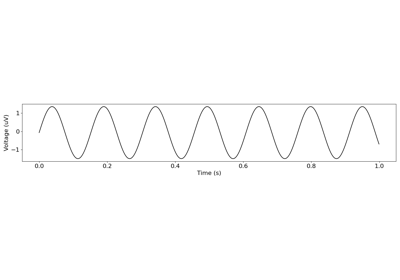neurodsp.sim.sim_bursty_oscillation¶
- neurodsp.sim.sim_bursty_oscillation(n_seconds, fs, freq, burst_def='prob', burst_params=None, cycle='sine', phase=0, **cycle_params)[source]¶
Simulate a bursty oscillation.
- Parameters:
- n_secondsfloat
Simulation time, in seconds.
- fsfloat
Sampling rate of simulated signal, in Hz.
- freqfloat
Oscillation frequency, in Hz.
- burst_def{‘prob’, ‘durations’} or 1d array
Which approach to take to define the bursts:
‘prob’ : simulate bursts based on probabilities of entering and leaving bursts states.
‘durations’ : simulate bursts based on lengths of bursts and inter-burst periods.
1d array: use the given array as a definition of the bursts
- burst_paramsdict
Parameters for the burst definition approach.
For the prob approach, should contain the following keys and values:enter_burst : float, optional, default: 0.2Probability of a cycle being oscillating given the last cycle is not oscillating.leave_burst : float, optional, default: 0.2Probability of a cycle not being oscillating given the last cycle is oscillating.For the durations approach, should contain the following keys and values:n_cycles_burst : intThe number of cycles within each burst.n_cycles_off : intThe number of non-bursting cycles, between bursts.- cycle{‘sine’, ‘asine’, ‘sawtooth’, ‘gaussian’, ‘exp’, ‘2exp’, ‘exp_cos’, ‘asym_harmonic’}
What type of oscillation cycle to simulate. See sim_cycle for details on cycle types and parameters.
- phasefloat or {‘min’, ‘max’}, optional, default: 0
If non-zero, applies a phase shift to the oscillation by rotating the cycle. If a float, the shift is defined as a relative proportion of cycle, between [0, 1]. If ‘min’ or ‘max’, the cycle is shifted to start at it’s minima or maxima.
- **cycle_params
Parameters for the simulated oscillation cycle.
- Returns:
- sig1d array
Simulated bursty oscillation.
Notes
This function takes a ‘tiled’ approach to simulating cycles, with evenly spaced and consistent cycles across the whole signal, that are either oscillating or not.
If the cycle length does not fit evenly into the simulated data length, then the last few samples will be non-oscillating.
Examples
Simulate a probabilistic bursty oscillation, with a low probability of bursting:
>>> sig = sim_bursty_oscillation(n_seconds=10, fs=500, freq=5, ... burst_params={'enter_burst' : 0.2, 'leave_burst' : 0.8})
Simulate a probabilistic bursty sawtooth oscillation, with a high probability of bursting:
>>> sig = sim_bursty_oscillation(n_seconds=10, fs=500, freq=5, burst_def='prob', ... burst_params = {'enter_burst' : 0.8, 'leave_burst' : 0.4}, ... cycle='sawtooth', width=0.3)
Simulate a bursty oscillation, with specified durations:
>>> sig = sim_bursty_oscillation(n_seconds=10, fs=500, freq=10, burst_def='durations', ... burst_params={'n_cycles_burst' : 3, 'n_cycles_off' : 3})
